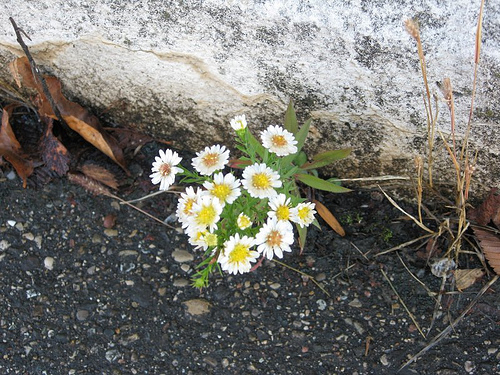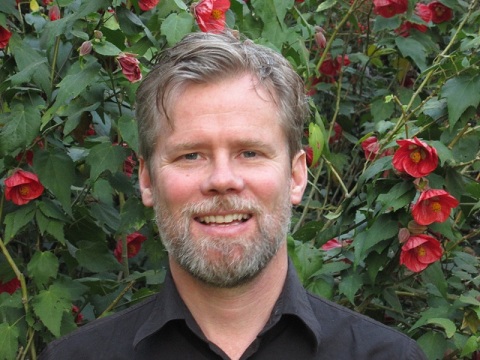Chris Byrne, a participant at D4R last Saturday, has catalyzed D4R’s first informal workgroup to discover a resilience pattern language. Chris’ curiosity, dialog skills, and insightful contributions to discussion inspired Peter+Trudy Johnson-Lenz, who blog at People & Place, to share their index of design philosophies for Chris to work with. They graciously agreed to share their index with Shareable. Thank you PTJL. See any patterns in these philosophies? Please share your observation in comments.
Brittle Power, by Lovins & Lovins
- small units dispersed in space
- redundancy
- short linkages between modules
- simplicity and repairability
- diversity of components
- self-reliance
- decentralized control
- large margins
- quick feedback
Permaculture Design Principles
https://permacultureprinciples.
- observe and interact
- catch and store energy
- obtain a yield
- apply self-regulation and accept feedback
- use and value renewable resources and sources
- produce no waste
- design from patterns to details
- integrate rather than segregate
- use small and slow solutions
- use and value diversity
- use edges and value the marginal
- creatively use and respond to change
Permaculture Principles
https://www.heathcote.org/
- conservation
- stacking functions
- repeating functions
- reciprocity
- appropriate scale
- diversity
- give away the surplus
Resilient City Design Principles
https://www.resilientcity.org/
- Carbon Dependency Reduction
- Systems Diversity
- Systems Redundancy
- Infrastructure Durability
- System Feedback Sensitivity
- Local Self-Sufficiency
- Responsive to Natural Systems
Urban Design Principles
https://www.resilientcity.org/
- Density, Diversity and Mix
- Pedestrians First
- Transit Supportive
- Place-Making
- Complete Communities
- Integrated Natural Systems
- Integrated Technical and Industrial Systems
- Local Sources
- Engaged Communities
- Redundant and Durable Life Safety and Critical Infrastructure Systems
- Resilient Operations
Resilient Building Design Principles
https://www.resilientcity.org/
- Use low carbon input materials and systems
- Design and plan buildings for low external energy inputs for ongoing building operations
- Design buildings for maximum day-lighting
- Design for future flexibility of use
- Design for durability and robustness
- Design for use of local materials and products
- Design and plan for low energy input constructability
- Design for use of building systems that can be serviced and maintained with local materials, parts and labour
Slow Knowledge Worldview
The Nature of Design,by David Orr
- Wisdom, not cleverness, is the proper aim of all true learning
- The velocity of knowledge can be inversely related to the acquisition of wisdom
- The careless application of knowledge can destroy the conditions that permit knowledge of any kind to flourish
- What ails us has less to do with the lack of knowledge but with too much irrelevant knowledge and the difficulty of assimilation, retrieval, and application as well as the lack of compassion and good judgment
- The rising volume of knowledge cannot compensate for a rising volume of errors caused by malfeasance and stupidity generated in large part by inappropriate knowledge
- The good character of knowledge creators is not irrelevant to the truth they intend to advance and its wider effects
- Human ignorance is not an entirely solvable problem; it is, rather, an inescapable part of the human condition
Ecological Design
The Nature of Design,by David Orr
- improve energy efficiency
- develop renewable sources of energy
- reduce materials per unit of output
- preserve biological diversity
- restore degraded ecosystems
- redesign transportation systems and urban areas
- institute sustainable agriculture and forestry practices
- reduce population growth and eventually total population levels
- redistribute resources fairly within and between generations
- develop more accurate indicators of prosperity, well-being, health, and security
Ecological Design Questions
The Nature of Design, by David Orr
- Do we need it?
- Is it ethical?
- What impact does it have on the community?
- Is it safe to make and use?
- Is it fair?
- Can it be repaired or reused?
- What is the full cost over its expected lifetime?
- Is there a better way to do it?
Principles of Living Machines
Eco-Cities to Living Machines: Principles of Ecological Design,by John Todd
- the living world is the matrix for all design
- design should follow, not oppose, the laws of life
- biological equity must determine design
- design must reflect bioregionality
- projects should be based on renewable energy sources
- design should be sustainable through the integration of living systems
- design should be coevolutionary with the natural world
- building and design should help heal the planet
- design should follow a sacred ecology
Principles of regenerative design
Regenerative Design for Sustainable Development,by John Lyle
- Let nature i.e. natural processes do the work for us
- Use nature as the model for human enterprise
- Aggregate functions and processes to create resilience
- Strive for optimum levels, not maximum
- Match technology to needs
- Replace power with information
- Provide multiple pathways
- Solve many problems simultaneously
- Manage storage as a key to sustainability
- Shape form to guide flow
- Shape form to manifest process
- Prioritize for sustainability
Stewardship design principles
https://www.slideshare.net/
- balance
- interdependence
- regeneration
- diversity
- succession
Principles of Biomimicry for Green Design
https://rs.resalliance.org/
- Waste = Food
- Self-assemble, from the ground up
- Evolve solutions, don’t plan them
- Relentlessly adjust to the here & now
- Cooperate AND compete, not just one or the other
- Diversify to fill every niche
- Gather energy & materials efficiently
- Optimize the system rather than maximizing components
- The whole is greater than the sum of its parts, design for swarm
- Use minimal energy & materials
- “Don’t foul your nest”
- Organize fractally
- Chemical reactions should be in water at normal temperature & pressure
- Vogel’s mechanical-engineering-
specific principles (summarized): - Nature’s factories produce things much larger, not smaller, than themselves
- We use metals, nature never does
- Nature makes gradual transitions in structures (curves, density gradients, etc.) rather than sharp corners
- We make things out of many components, each of which is homogeneous; nature makes things out of fewer components but they vary internally
- We design for stiffness, nature designs for strength and toughness
- Our mechanisms have rigid pieces moving on sliding contacts, nature bends/twists/stretches
- Nature often uses diffusion, surface tension, and laminar flow; we often use gravity, thermal conductivity, and turbulence
- Our engines are mostly rotary or expansive, nature’s are mostly sliding or contracting
- Nature’s engines are isothermal
- Nature mostly stores mechanical work as elastic energy, sometimes as gravitational potential energy
Principles of biomimetic products
https://www.biomimicryguild.
- Are sustainable
- Perform well
- Save Energy
- Cut Material Costs
- Redefine and Eliminate “Waste”
- Heighten existing product categories
- Define new product categories and industries
- Drive Revenue
- Build Your Brand
Principles of structural tension
https://www.gavrielshaw.com/
Tension is the basic unit of Structure
- Tension exists out of discrepancy: It is a dynamic of structure that causes energy to move along the path of least resistance
- The path of least resistance is the principle that in nature, energy moves where it is easiest to go
- Structural tension is the discrepancy between two states, our desired state as compared to our current state
Principles of working with the grain
DRAFT, Peter and Trudy Johnson-Lenz, 2009
- leverage natural process
- follow natural designs
- understand context
- distribute value
- develop diversity
- optimize — don’t maximize
- heed resistance
- influence mutually
others:
- distributed organization is more resilient and adaptive
- actions are more effective when all stakeholders engage
- value is more effectively negotiated when all its forms are accounted over time and levels of identity
Principles of inherent interdependence
DRAFT, Peter and Trudy Johnson-Lenz, 2009
- sustaining identity ( conservation of identity )
- identity is simple self: you or me
- identity values what sustains it
- identity produces value in exchange for what sustains it
- engaging whole ( mutually gainful exchange )
- engagement is complex self: you and me = we
- engaging identities negotiate and exchange mutual satisfactory gains
- identities value engagements that yield gains
- engagement distributes value
- authentic communication is voluntary, accurate, and complete
- mutual authenticity produces mutual knowledge
- mutual knowledge produces mutual gains
- engaging whole is authentic and accountable engagement
- engaging whole produces mutual gains
- perpetual prototyping ( duration through change )
- everything is a prototype
- each form prototypes the next
- prototyping leverages the value of mistakes
- prototyping innovates value
- engagements to prototype produce new value
- engagements to prototype prototyping improve innovation
- identity values innovation that sustains it
- orienting innovation toward what is valued increases its value
- everything is something’s lunch
- life values death
Tensegrity:
- tensegrity is a resilient form emerging from a network of interactions in which tension from differentiating forces pushing the network apart is transformed into strength by equal and opposite integrating forces pulling it together, amplifying and dynamically distributing the tension; the resulting resilience is proportional to the degree of balance, distribution, and expression of both forces
- a tensegrity of engagements is an engagement that resiliently produces mutual gains by amplifying and distributing tensions among diverse cooperating and competing self-interests
- a tensegrity of prototyping engagements resiliently produces and distributes innovation
- a self-prototyping tensegrity of prototyping engagements resiliently innovates itself
- nature is a self-prototyping tensegrity of prototyping engagements









